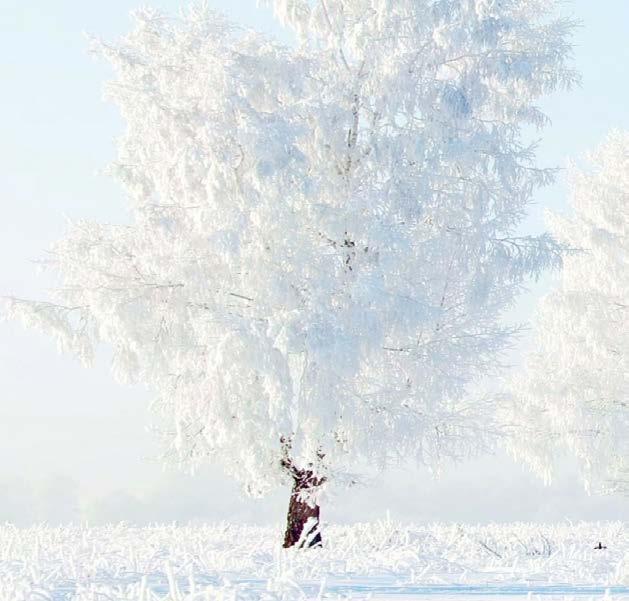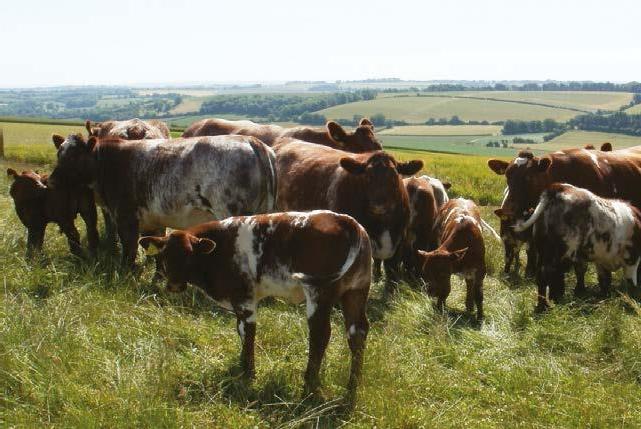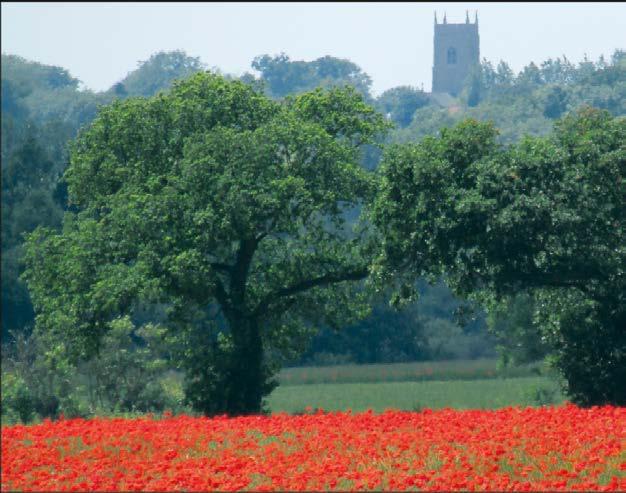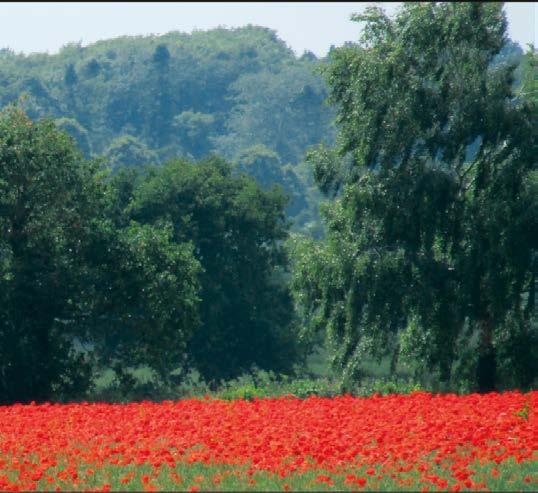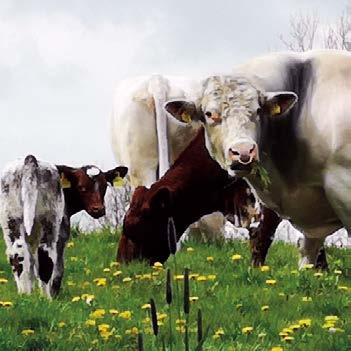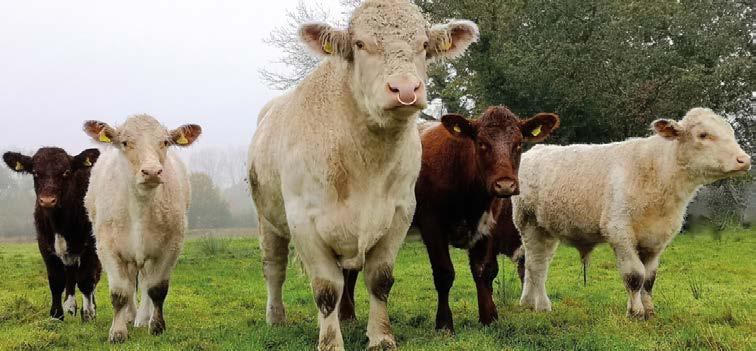
13 minute read
Beef Shorthorn fitting regenerative systems
Beef Shorthorn fitting future regenerative systems
Regenerative grazing systems are a relative new concept to livestock farmers, however they are finding they’re able to build greater resilience to fluctuations in weather patterns and market prices by working more closely with nature and reducing interventions.
Advertisement
The system involves higher-intensity, short grazing periods with long resting times in-between, using a system of paddocks. It keeps the sward height high and encourages regrowth and development of plant and root systems, which also improves soil microbiology and function.
This type of management helps to improve soil condition, biodiversity and livestock health, and maintain steadier financial margins against the backdrop of reduced support payments and increasing input costs.
We explore two systems successfully farming Beef Shorthorn yet operating in contrasting regions - a mixed lowland unit in the Home Counties and a hard hill Lake District farm.
Farming for profit and sustainability
Fact FILE
The Cherry family is farming a regenerative system for the future, one that is profitable and sustainable. “We’ve developed a simple regime with livestock which requires relatively little management input,” explains John Cherry who farms with his brother Paul and nephew, Alexander. “We are focused on making the cows do all the work, and we’ve found that our Beef Shorthorn have proved they can be integrated in to a profitable enterprise, they are able to deliver and make money.
“They’re great natural grazers, they have that essential quiet temperament and the nice thing is they tend to look after themselves and go on to achieve above average performance.” Beef Shorthorn herd KPIs • 92% calves reared per cows put to the bull • 90% calve in spring within the first six weeks • 100% within the first two months. • Calves weaned at 10 months having achieved an average 0.95kg DLG • Replacement heifers selected according to their dam’s performance, size, and temperament • Introduced to the bull at 13 to 14 months; average 370kg to calve at 24 months • Mature weight average 670kg
The Cherry’s quest for a functional suckler cow led them to invest in Beef Shorthorn in 2001. “We used to buy in black Hereford crosses, however BSE put a stop to that; we moved on to Continental crosses yet they proved to be not the best mothers. We wanted to breed better replacements, so next up was introducing a Beef Shorthorn Darnalls Hall Farm, Baldock, Herts
810ha arable
200ha permanent pasture and woods
130 cow commercial Beef Shorthorn suckler herd
Variable soil type: chalky boulder clay
John Cherry
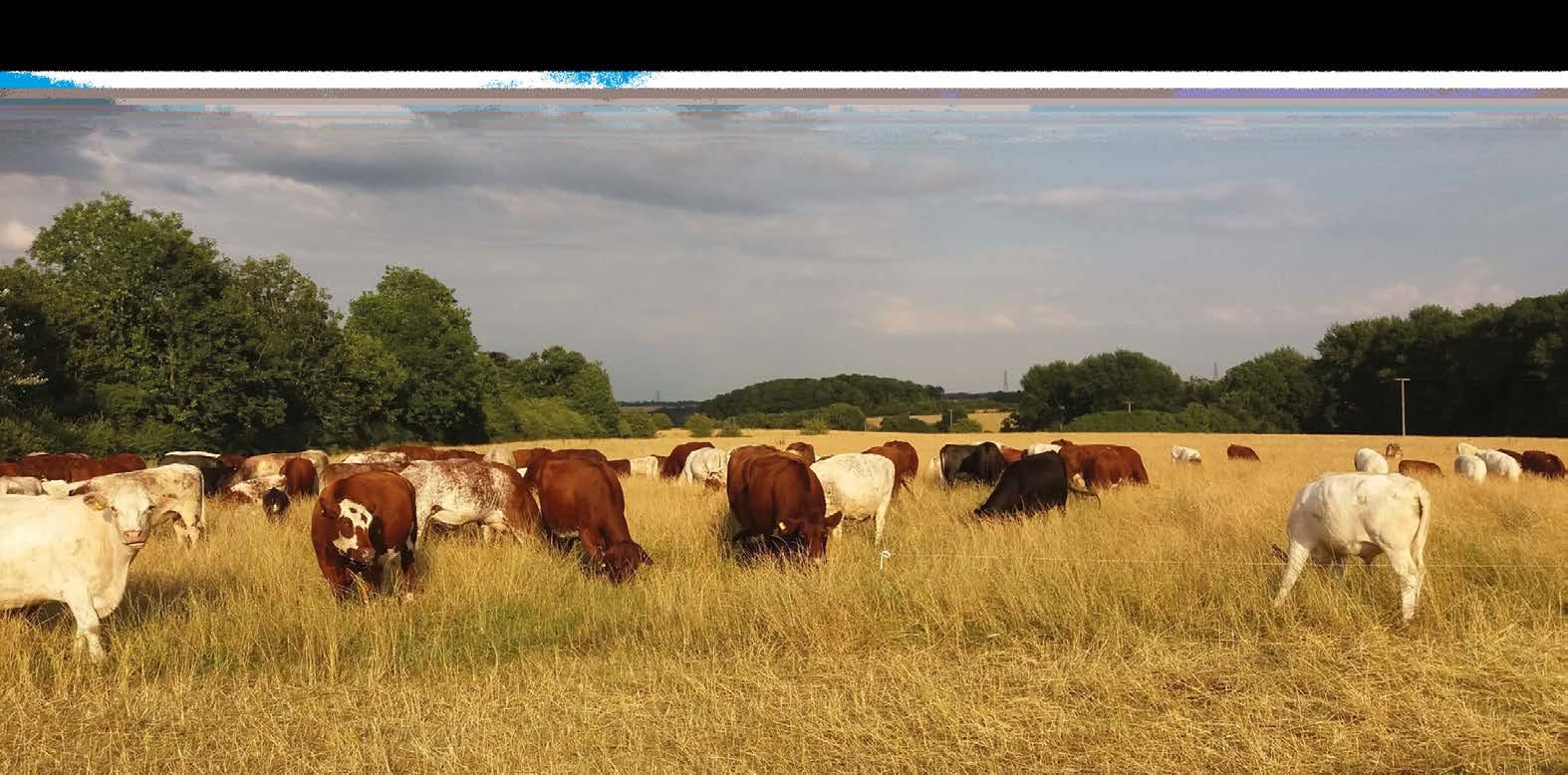
bull, we found the genetics seemed to fit and since then the herd has become progressively pure. We are introducing two hybrid Hereford/Angus bulls this year to try and keep the cow size down and bring in some hybrid vigour.
“Compared with our previous Continental cows, Beef Shorthorn make for very good mothers; they’re real fighters. They just don’t give up. Each cow will make a big effort to look after her calf and enable it to suck if necessary. We get involved in perhaps one in 30 calvings, however the vast majority will calve on their own providing we get body condition score right and that is encouraged by our winter management regime which enables the cows to stay lean until calving commences in March. We’ve noticed the later calvers do best, so in 2021 we are delayed introducing the bull until the beginning of July.”
He adds: “We farm on the fringes of a village which is surrounded by frequently used public footpaths. Beef Shorthorn have a benign temperament, as well as a good forage conversion ability, which not only makes for ease of management, but also safety.”
Bulling heifers, cows and calves mob grazing permanent pasture
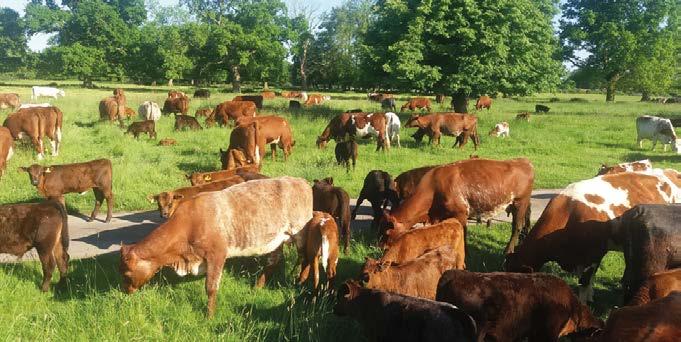
Mob grazing: the strategy was introduced 10 years ago to permanent pasture and short-term herbal leys on the arable land from March through to December, the length of winter being dependant on the weather.
Two main mobs are run in the grazing season.
• Main mob, of about 220 animals consists of bulling heifers, cow and their calves. • Second mob is made up of about a 100 yearlings and cull cows and their calves. • A further, smaller mob of older animals close to finishing is run nearer to farm buildings, to ease drafting off fit animals.
The main mob is grazed predominantly on permanent pastures, whilst the yearlings get the herbal leys. They are all kept in small areas and moved every day onto the next parcel. The size of each cell depends, of course, on the amount of grass in it. In the spring, before grass growth really gets going, the big mob may get 2.0ha or more every day, in June that would shrink to 0.5ha, the young ones will be in even smaller cells.
Our objective is to balance the needs of the animals with the best interest of the plants that feed them and the soil below. The forage is allowed to grow tall, which makes best use of how grasses want to grow. This also encourages the grass-roots to probe deeper into the soil, making better use of available water and nutrients and as a result, no fertiliser is needed. Likewise, no herbicide is used as the mob eats everything in its path, so docks and thistles never get a hold or get swamped out by tall grass.
The aim is to get the cattle to eat a third, trample a third and leave a third of what is in front of them. The third, or normally at least a half which they consume is the most nourishing segment, the stuff they trample makes a protective mulch over the soil to keep the temperature perfect for grass growth and the remaining green stuff acts as solar panels to recharge the system ready to grow back before the herd returns. The plan is to give each cell between 60 and 90 days rest between grazings. the poorer permanent pasture, the young ones thrive on the herbal leys. These are undersown in a spring cereal crop and comprise 19 or so species of grasses, clovers, vetches and trefoils and other broadleaves such as chicory, parsley and yarrow. Not every species survives, but enough do to provide everything the young animal needs. Because they are run on a similar 60+ day circuit, wormers are not required and we don’t provide minerals - the deep rooting herbs appear to provide all that the growing animal requires. The ley will normally be kept for four years, then the land is returned to arable for a few years of cropping.
Moving the mob doesn’t take long - five or 10 minutes to roll out the electric cable for a new cell; the size required is calculated by judging how well they’ve consumed the last one, a couple of minutes watching the animals troop past as the electric fence is reeled in and a few minutes to roll up the empty cell fence or create a corridor to the water tank. It’s much easier to observe the herd when it moves, compared to finding set-stocked animals who may be dotted about all over the parish. Any animals with problems such as lameness are easily spotted.
Apart from being an efficient method of grazing, mob grazing is all about improving the ecosystem and in turn, grass quality. When we set stocked, heavy rain water used to rush off the land, whereas mob grazing has enabled a mat of grass and subsoil life to develop and the water is now absorbed. Poaching on heavier land has also been reduced. Grazing fresh grass has also eliminated the parasite burden, together with use of wormers.
The herd is overwintered once the ground gets too wet, normally around Christmas time, in open air corals bedded with woodchip and straw and fed homegrown permanent pasture silage, straw and any failed cereal or weed silage.
The bedding produces an annual 1,500 tonnes FYM which is composted and spread on arable land. Add the natural fertility which the grazing herd is leaving behind and N, P or K is no longer applied to the grazing swards, which make a significant contribution to our low cost, effective system.
Traditional Beef Shorthorns are helping a Lake District farming couple unlock the potential on their upland farm, as Sarah Alderton found out when she visited.
Beef Shorthorn cattle are central to the regenerative and future-proofed approach to farming which Sam and Claire Beaumont are adopting on their upland farm surrounding the shores of Lake Ullswater in Cumbria.
After taking on Gowbarrow Hall Farm from Claire’s family in 2017, they set about replacing the 240 Swaledale ewe flock, which returned an annual meagre £600 profit, with a herd of traditional Beef Shorthorn cows, a breed that would have once grazed the Lakeland fells.
The couple knew if they wanted to make a profitable and sustainable living from the upland farm without any farm support payments, the farming method had to consider the entire ecosystem. This led to them adopting a hybrid of rewilding and regenerative agriculture with Beef Shorthorn cattle central to the process.
Starting with just four Beef Shorthorns in 2017 bought from Longtown Market and chosen because they are hardy, maternal and can grow well, the herd now totals 51 head with 17 cows, 25 followers and nine finishing stock. “We also chose Beef Shorthorn as they are a breed that is native to the area. We know that back in the 1930s there was a herd of Shorthorns on the farm,” says Claire.
Any animals not retained for breeding are sold at around 29 months at 650-700kg and 330-360kg target deadweight; all cattle are Pasture for Life certified 100% grass-fed and sold via a local Kendal butcher or through their own meat box scheme.
The cows are the primary source of income on the 156ha farm. Working with regenerative agriculture expert Caroline Grindrod, of Wilderculture CIC the couple have designed a farm system that consists of two main blocks.
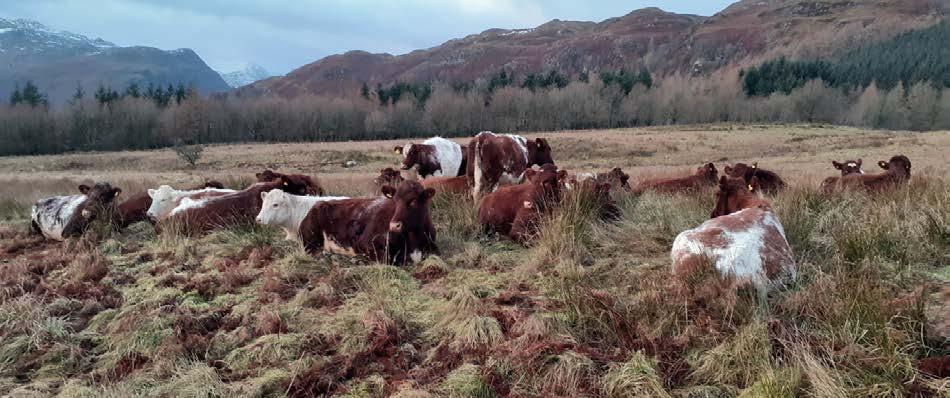
The herd outwintering on deferred grazing at Gowbarrow
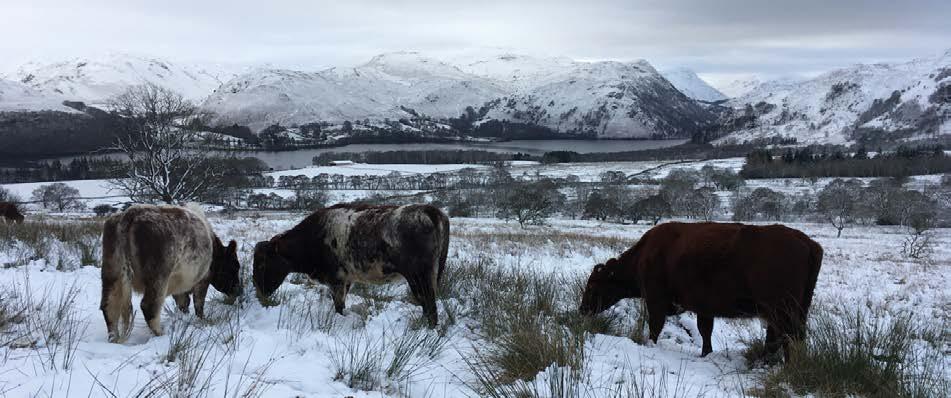
…and a few weeks later
Spring summer block
• Mob (regenerative) grazing 42ha lower meadows from April/ May when calving commences • Entire herd, grazed as one mob except the breeding bull and a steer • Youngstock also mob grazed on these meadows throughout the winter after December weaning • Solar energiser powers electric fencing powered separating paddocks in to 1-2ha • Cows are moved every one to three days, depending on time of year and grass growth • Each paddock left to rest for 45 to 120 days; rest day lengths increase later in summer to over 90 days • Water provided via a mobile water trough, gravity fed through a network of pipes Winter block
• 82ha block deferred grazing including woodland where store cattle and dry cows outwintered • Grazed from December weaning to April/May • Ground left ungrazed for the entire summer by cattle and four
Kune Kune pigs • It is hoped, in time, this area will revert to wood pasture
The average stocking rate is 0.4LU/ha, with the herd still growing. Stocking rates are set to increase to 0.6LU/ha in a few years; 17 cows were bulled in 2021, with six heifers to add to the herd in 2022.
The couple are slowly building the herd by breeding their own replacements, but admit they don’t know how far they will grow since what they are doing is
unpractised. Claire says: “We don’t know the farm’s capacity, however we want it to have a complete ecosystem, and the cows are an important part of that. We don’t want to push it too far,” she says.
Breeding aims
Sam explains: “We are currently refining the herd by removing some of the larger cows weighing more than 600kg and focusing on breeding a smaller and more traditional Beef Shorthorn cow that has shorter legs and a deeper body which helps them to digest fibre better. We would prefer to have 30 small cows on the farm than 20 big cows. Butchers don’t want animals with long legs, the bones are just trade waste.
“This system is better for our farm as it enables us to have a higher stocking rate and is more conducive to outwintering as the lighter the cattle, the less chance of poaching. Our ideal cow weighs between 500-600kg,” he adds.
The herd’s fertility is excellent, with all cows calving in a five-week block at the end of April. All cows were in calf within their first two cycles. The bull, however, is left with the cows for three cycles from mid-July. As a result, they had no returns to service this year and only one cow didn’t get in calf.
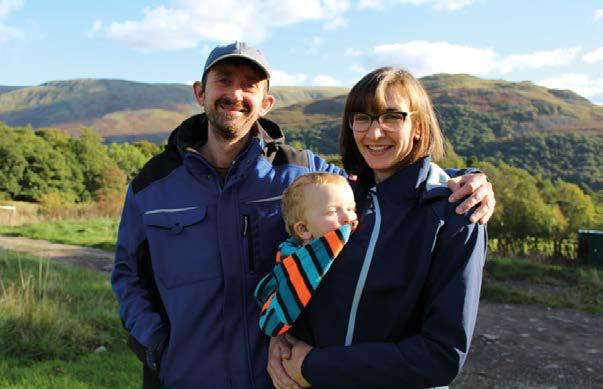
Sam and Claire Beaumont with Ike
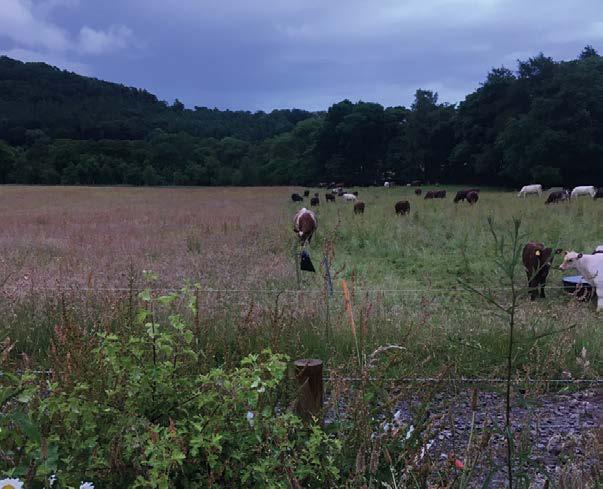
Mob grazing the spring summer paddocks
Sam says: “We think the bull covers the cows a lot better as he serves the cows in a paddock and doesn’t have to run as far.”
Farm outputs
The Beaumonts aim for the farm to be a profitable and sustainable business, which is something they are already achieving.
Cattle are finished entirely off pasture, with the only bought in product on the farm being some mineral seaweed, which is offered in the winter to offset an iodine deficiency. “The last bullock we killed was 29 months old, weighed 700kg liveweight, and killed out at 360kg deadweight. Finishing cattle are averaging between 1.2kg to1.5kg a day off grass alone. Some hay is offered in the winter, but we are not buying in any concentrates or using any fertiliser,” Sam explains.
By managing the cattle in this way, the couple returns a gross income of about £2,500 for each animal processed for beef, returning a net profit of up to £1,600. “Aside from the Basic Payment Scheme and environmental schemes, we are looking at the beef enterprise as a standalone business. Already we are making a lot more money than the sheep were and returning a living from the land.
“Beef Shorthorn fits this system well as the mothers are milky, fertile, grow well and are natural foragers meaning they make the most of this upland farm. They are also long-lived, with the average cow age in our herd being between six and seven years,” he says.
Sam says vet and med costs have also decreased since mob grazing as they are no longer having to worm adult cattle due to the grass being cleaner following more extended rest periods. All stock is still treated for fluke in the autumn as it is a challenge. However, the couple is already looking to minimise fluke by introducing poultry to eat the fluke intermediary host, the mud snail.
Fact FILE
156ha permanent grassland, all classed as either severely disadvantaged area (SDA) or SDA moorland. This includes 32ha moss fell, 82ha rough grazing and wood pasture and 42ha meadows
All in mid-tier stewardship. Currently applying for higher tier stewardship and undertaking feasibility studies for this
Farm extends to 1,400ft above sea level
Closed herd of 51 Beef Shorthorn cattle; breeding for traditional smaller cows with a 500600kg mature weight
Four Kune Kune pigs and four Fell ponies
Farm split into two blocks - summer and winter grazing. All cattle grazed as one mob in the summer, with stores and cows grazed in the winter block from December and youngstock on the lower ground
100% cows calving in first two cycles in a five-week block
Average cow age six to seven years.
